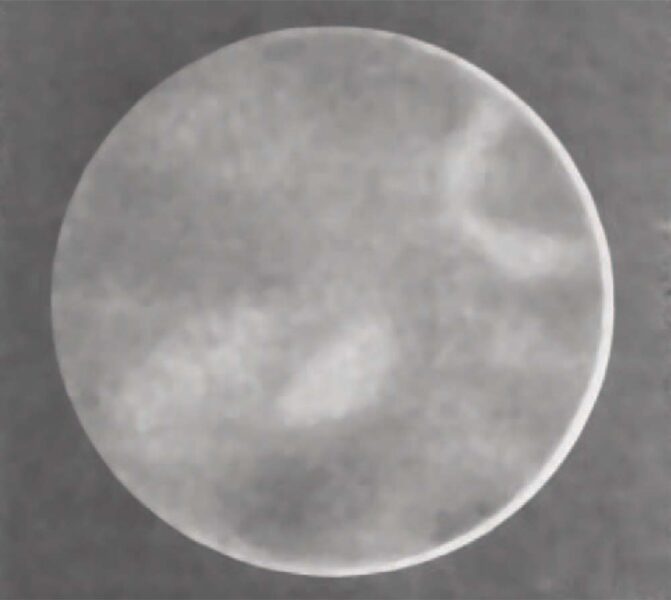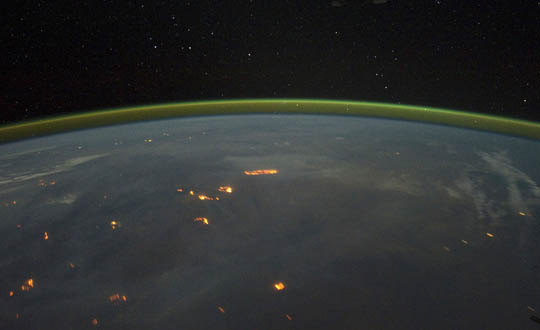A visible glow from our sister planet’s nightside sheds new light on a 300-year-old observing enigma dubbed the “ashen light.”

NASA / Johns Hopkins APL / Naval Research Laboratory (left); Magellan Team / Jet Propulsion Laboratory / United States Geological Survey (right)
NASA’s Parker Solar Probe, launched in 2018, is using a series of seven gravity-assist flybys of Venus to gradually spiral closer to the Sun. The spacecraft’s widefield camera, dubbed WISPR, was designed to take images of the outermost reaches of the Sun’s atmosphere and the solar wind in visible light. But turned toward Venus, WISPR revealed some unexpected results.
Visible light images of the planet’s nightside captured during the third and fourth flybys astonished the mission team, who published their findings in the February 16th Geophysical Research Letters. These pictures contain tantalizing clues that may help solve one of observational astronomy’s oldest and most enduring mysteries.
Venus Glows Dull Red, Like Iron from a Forge
For telescopic observers Venus is invariably a disappointing sight, because an unbroken canopy of clouds and haze conceals the planet’s surface from prying eyes. However, during the early 1980s, astronomers discovered that this veil is partially transparent at wavelengths invisible to the human eye, in the near-infrared region of the spectrum. At 800 to 1,100 nanometers, it is possible to image the planet’s nightside surface, which bakes at a furnace-like temperature of 460°C (860°F) and glows like a piece of iron pulled from a forge.
At these near-infrared wavelengths, Venus’s nightside has a dappled appearance that roughly corresponds to the surface topography that NASA’s Magellan spacecraft mapped in the early 1990s using radar to penetrate the thick clouds. The slightly cooler highlands appear darker than the surrounding lowlands.
In 2006 Frederick Taylor (Oxford University, UK) speculated that the clouds and hazes might also be translucent in the visible region of the spectrum. Indeed, that’s exactly what the Parker Solar Probe’s images reveal: WISPR’s visible-light images of the planet’s nightside look like slightly blurred, reduced-contrast versions of the near-infrared images. Although four-fifths of the surface’s reddish glow is absorbed and scattered by Venus’s dense atmosphere and low-lying clouds of sulfuric acid aerosols, one-fifth manages to penetrate the blanket of gas and mist.

NASA / Johns Hopkins APL / Naval Research Laboratory
The Answer to the “Ashen Light”?
The unexpected finding might be the answer to the great unsolved riddle known as the “ashen light.” For more than 300 years, credible telescopic observers have reported a faint glow emanating from Venus’s nightside. Only sporadically visible, this elusive phenomenon is usually glimpsed when the planet appears as a slender crescent. Although the ashen light is often described as a uniform, colorless glow, over the years some observers have remarked on its mottled appearance as well as its warm ruddy hue.

In recent years the ashen light has been written off as an optical illusion by many authorities. There’s no denying that the human eye–brain combination has an insidious tendency to fill in or complete the figure of a crescent. I’ve seen the ashen light only once, almost four decades ago, but I remain convinced that what I saw was no illusion. The WISPR images of the visible glow lend credibility to my eyepiece impressions — a ghostly light marred by a diffuse dark blotch — that still remain vivid after so many years.
A decade ago, planetary scientist Dale Cruikshank (NASA Ames) calculated the amount of visible light in the dull-red glow of Venus’s nightside and its apparent brightness from an earthly vantage point. Cruikshank’s luminance value exceeds the brighter portions of the Milky Way by a factor of 20, but the Parker Solar Probe team estimates that almost 80% of this light is absorbed or scattered.
Alternative Explanations
A vexing question remains: Is it possible to make out that feeble remnant in close proximity to the dazzling glare of the sunlit crescent?
Richard McKim, who served as director of the British Astronomical Association’s Venus Section from 2004 to 2019, thinks it is. He attributes that the changing visibility of the ashen light to variations in the thickness of low-level clouds and perhaps even to the level of volcanic activity.
However, Brian Wood (U.S. Naval Research Laboratory), lead author of the Geophysical Research Letters paper, hesitates to attribute the ashen light to surface heat because the human eye is most sensitive to green light and far less so to red.
Instead, Wood suspects that a green emission feature recorded in WISPR images might be a more plausible explanation. During the day, intense ultraviolet radiation from the Sun breaks down carbon dioxide molecules in the upper Venusian atmosphere, liberating oxygen atoms. Fierce 200 mph winds rapidly transport these energized atoms to the planet’s night side, where they slowly combine to form molecular oxygen (O2). The energy released by this reaction emits green light.

NASA
First detected during the 1970s by the Soviet Venera 9 and Venera 10 spacecraft, the oxygen airglow brightens and fades dramatically depending on the level of solar activity. In WISPR images it’s prominent along the planet’s limb, where the depth of atmosphere along the line of sight is greatest. This feature may correspond to the “woolen thread,” a narrow glowing band outlining the edge of the ashen light that British observer Valdemar Firsoff saw on several occasions during the 1950s and 60s.
Wood points out that the dense atmosphere is also quite effective at refracting sunlight from the dayside and wonders if a perceptible amount might reach all the way to center of the nightside. “It's clearly there at some level in the WISPR images and older Venus Express orbiter data,” he suggests. “A lot more work has to be done to quantify it, but this light would certainly be at wavelengths the eye would be very sensitive to.”
The Parker Solar Probe team plans to acquire more data during the spacecraft’s final flyby of Venus in November 2024, which will give the probe a final opportunity to capture the planet’s nightside. Meanwhile, they encourage earthbound observers to gather more data as well, writing, “It would be a worthwhile project for both amateur and professional astronomers to assess whether the optical surface emission seen by PSP/WISPR might be sufficiently bright to be observable from the ground.”
 0
0









Comments
You must be logged in to post a comment.